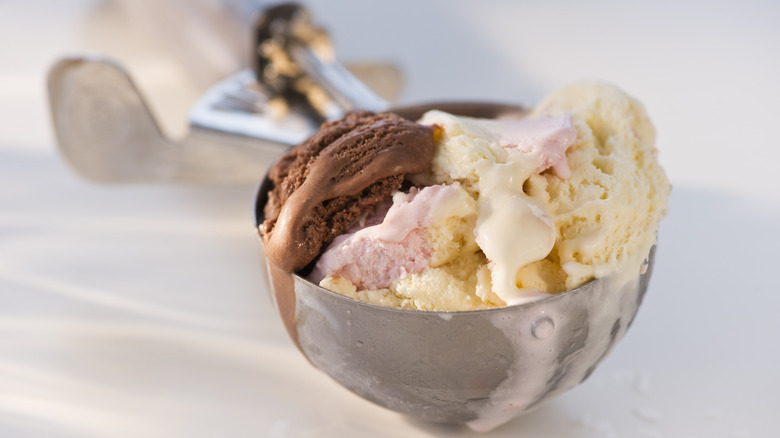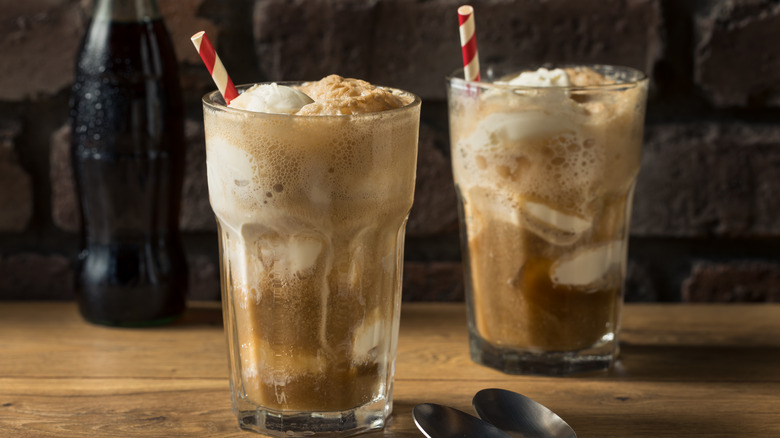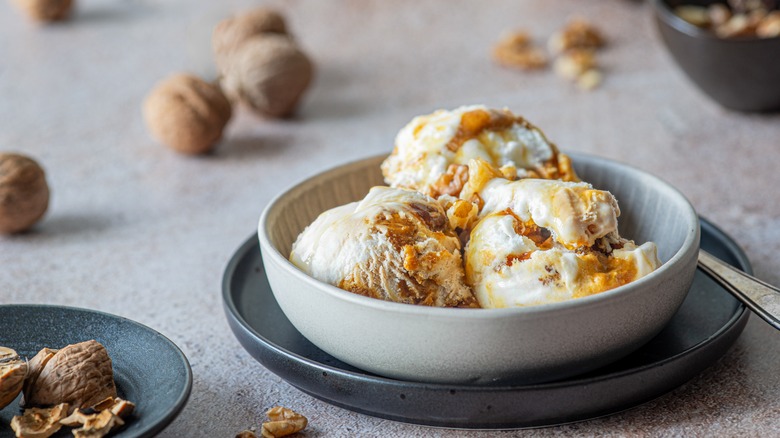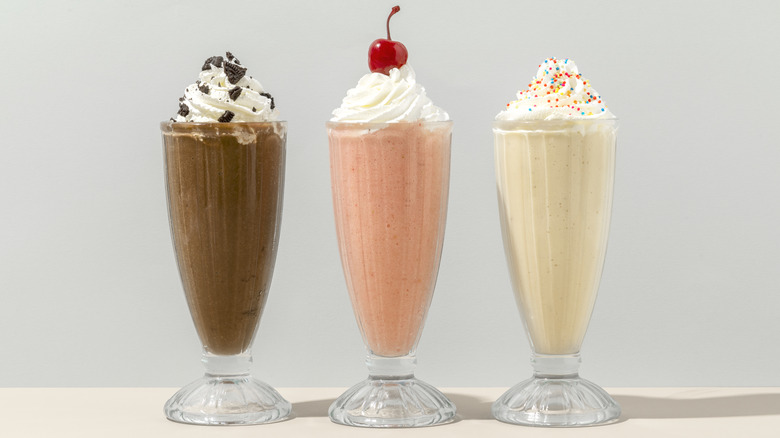Popular Ice Cream Styles And Flavors From Decades Past
We all scream for ice cream, and we have been for a while. People's love for ice cream is nothing new, and the sweet treat has been at the center of dessert culture steadily since the early to mid-1900s. Over the last century, many flavors and styles have gone in and out of popularity, but they all remain a tasty part of our history. We've consulted three experts on the creamy dessert to give us the rundown on some of the most iconic forms ice cream has taken throughout the decades.
We turned to Everett Reed, who owns EC Reed's Mercantile Hotel Soda Shop and Luncheonette, for all things traditional ice cream. His classic ice cream soda shop serves up thousands of possible dessert combinations that reflect techniques that were used in the 1940s. We also spoke with Kelly Larson, president of the North American Ice Cream Association and owner of Sweet Temptations in Grand Haven, Michigan. Ice cream innovator Lindsay Grecka represents the newer generations of ice cream lovers. She meticulously handcrafts unique flavors for Lindsay's Handmade, taking inspiration from many cultures and times gone by.
With the help of these three ice cream slingers, we've compiled a list of ice cream flavors and styles that were all the rage in past decades. You may want to sate your sweet tooth before reading this, because some of these flavors and styles could be hard to find in the modern world.
Pralines and Cream
Taste is one of the gateways to memory, and pralines and cream will take you back. The flavor is one of the many grandma-approved flavors on this list, though it certainly isn't the oldest. Relative to ice cream itself, Pralines and Cream would almost be considered young. It was created in 1970, an invention of the ice cream giant Baskin-Robbins, as Pralines 'N Cream. The ice cream was originally vanilla with praline inclusions and a drizzle of caramel, though the flavor has since been recreated countless times.
Though pralines and cream was wildly popular for decades after its invention, younger generations may not even know what a praline is. They're almost like a candied pecan, and are made with sugar, vanilla, and nuts. As such, the ice cream flavor is almost overly sweet and has a nutty profile. The decline in popularity for this once beloved flavor has met with devastation from some long time fans. Though Baskin-Robbins still claim they sell the flavor, Reddit users have expressed their heartbreak at not being able to find it anymore. Luckily, hand scoop ice cream shops may still carry some of this classic flavor.
Peppermint
When you think of mint ice cream, your mind probably jumps straight to the light green mint chocolate chip kind. This mint green dessert certainly has its fans, but the peppermint ice cream can be as pink as bubblegum or as red as Santa's hat. This makes sense, as the flavor now is typically seasonal. With its close relationship to candy canes, the ice cream flavor makes an ideal Christmas dessert.
The flavor was made popular by Baskin-Robbins, who first came out with that light green mint that we'd be more likely to recognize today. After a few years of picking and prodding at the recipe, though, the green turned to pink. The brand's peppermint ice cream now has a distinct separation between the peppermint flavor and the mint chocolate chip. The rest of the ice cream world and those who scream for it hold the same distinction, and typically only look toward true peppermint when winter rolls around.
Butter Pecan
Butter pecan is probably the most beloved classic ice cream flavor there is among older generations. This is, of course, minus the ones that are still incredibly popular, like the holy trinity of vanilla, chocolate, and strawberry. Its sweet and nutty taste just scratches an itch for those who have lived in previous generations.
Kelly Larson and Everett Reed both named butter pecan as a staple classic flavor and one that is chosen by those of an older generation. Reed went as far as to say that he does keep some butter pecan made on hand, as his requests for it are so frequent. Though it is a favorite for many with tastes stuck in another age, butter pecan's history may be a bit darker than you expect. Back in the Jim Crow era, it's said that Black people couldn't buy vanilla, which made creating the base to most ice creams pretty difficult. Instead, they turned to a butter-based option, like butter pecan. As such, the flavor may be a symbol for some of its champions or finding the sweetness in hardship. Whatever the reason for it, though, butter pecan stands as one of the go-to flavors from decades past.
Slow Churn Ice Cream
As technology has advanced, new ways to make ice cream have surfaced. Inevitably, as is with most things, the old ways have been left behind. These newer methods may come with the perks of being easier and faster, but they have also altered the taste and texture of ice cream. You don't really see people hand churning ice cream these days, but some of the classic methods still persist with those who appreciate the way ice cream used to taste.
One of these champions of the old ways is our expert Everett Reed, who uses a vertical churn at low speeds in an attempt to recreate the texture of ice cream from times gone by. Reed told us that modern machines revolve 200 times in a minute, which is faster than his approach, his exact speed being one of his trade secrets. "The speed of the churning is what introduces air into the ice cream ... [This] is the chief defining factor in mouth feel. It will also affect the flavor," he explained.
You may be surprised at how much the modern ice cream you know and love differs from how it felt and tasted to your grandparents. What most people are used to now is a mass marketed product. Thankfully, there are pockets of the past, like Reed's soda fountain, that help preserve the ice cream experience of the '40s and '50s.
Peach
Have you noticed a theme happening with the flavors from decades past that grace this list? Quite a lot of flavors come straight from nature, peach being yet another of them. The ice cream makers back in the day did not have nearly as many products or means for shipping and sources as makers do today. So, they looked to the easily accessible ingredients, which would very often be those around them in nature.
Peach ice cream is incredibly old school, and predates many of the other flavors on this list. It was made and already relatively popular in the 19th century. We do not see much of the peach flavored ice cream today, and it's much more likely to come in a fruity sherbet or sorbet. Even so, Everett Reed revealed that he does get the occasional request or special order for the flavor at his soda fountain ice cream shop.
Neapolitan
Neapolitan ice cream is timeless, and easily identified by the blocked layers of flavor. While traditionally Neapolitan ice cream could be a number of flavors blocked together, the iconic pink, white, and brown layers have become the standard and expectation. Equal parts vanilla, chocolate, and strawberry, the flavor is the answer to many choosey ice cream fanatics.
The layered ice cream flavor is named after the Italian city of Naples and came to America with Italian immigrants. The inspiration for such a flavor is directly related to another Italian dessert called spumoni. Spumoni consists of layered gelato flavors, typically pistachio, chocolate, and a cherry, with nut and fruit inclusions.
Though it has been a popular flavor as far back as the 1800s, a much more recent memory can be attributed to the trio. The flavor is still sold by the large tub, and many childhoods have been a freezer burnt tub of Neapolitan at the center of a core memory. It's not really a surprise that the flavor has stuck around and has seen such a success. Since it is made up of three of the most popular and staple ice cream flavors of all time, it really offers a great solution for families and individuals with varying tastes.
Rum Raisin
Like Neapolitan, Rum Raisin ice cream is the product of another Italian dessert. Sicilian málaga gelato consists of rum-soaked raisins and vanilla gelato, and it wasn't long until the flavor combination made its way to America. Other flavors like cinnamon and caramel are sometimes added, but the original trio or rum, raisin, and vanilla remain a base for this ice cream.
Rum Raisin is undeniably one of the "grandma" flavors of the list, as it is the older generations we typically see enjoying it. Even so, younger folks are still welcome to consume it. The rum is, for the most part, absorbed and though small traces of alcohol are present, the ice cream is not considered alcoholic. If there were too much rum still present in the dessert, it would have a hard time freezing!
The distinct taste of rum is still very present in the ice cream, though this will vary by batch or brand. The rum helps give the ice cream and complex flavor while maintaining some of the sweetness. Alcohol and dessert have and continue to be paired with one another, and rum raisin's popularity has fluctuated throughout the decades. Popular in the '30s and again in the '80s, we may see a resurgence of this classic flavor yet again, especially as whiskey ice cream enters the chat.
Ice Cream Soda
Soda fountains of the '40s and '50s are akin to what bars are now, minus the alcohol. The soda bartenders, called jerks, created almost countless flavors with their soda water and syrup combinations. Ice cream was served right alongside these sweet, sometimes even medicinal sodas. This marriage created the delectable dessert that we now call a float. Creating these ice cream sodas was much more than popping a tab on a root beer bottle and pouring the soda over ice cream though. Fountain jerks were almost like alchemists mixing their liquid gold, every soda handmade and measured to bubbly perfection.
Everett Reed, an expert in all things ice cream soda, explained to Mashed how soda fountains were originally drugstores and soda was seen as medicinal. "Soda fountains were ... installed and touted as medicinal because they believed carbonated mineral water to be a health aid." Reed goes on to say the use of syrups in the soda was simply an aid to take people's so-called medicine, "The mineral water was sweetened, flavored, and mixed with the medicines of the day to make them more palatable."
There are not many traditional soda fountains left, but if you find one, it'll be like walking into a different decade. Don't be surprised when the soda doesn't taste like what you're used to, either, as it will be all around cleaner. The hand mixed sodas, even without adding ice cream, will be an experience from another time.
Maple Walnut
Maple Walnut is yet another ice cream flavor that you've probably noticed the oldest members of your family gravitating toward. As much as your grandparents may love it, younger people usually skip right over it when peering into the ice cream freezer. This disparity in the generations' preference for one flavor to another may not simply come down to personal taste, but personal memory.
Lindsay Grecka, who usually crafts new and unique flavors for her small batch shop, holds that there is something special about a classic flavor like maple walnut. "I have learned that this is very much a nostalgia flavor for a lot of people. A lot of my senior customers go for this flavor. And when customers of my own generation order it, they often say it reminds them of their grandparent, that was what they always ordered, it was their favorite." The only thing sweeter than ice cream is a good memory, and maple walnut offers both on a cone.
Butter Brickle
If you are from a younger generation, you may have never even heard of Butter Brickle. Even if Butter Brickle is unfamiliar to you by name, you'll likely recognize its appearance and taste. The flavor persists as the inspiration to many similarly flavored ice creams, like Heath Bar or a toffee crunch. Butter Brickle, like Heath, is a sweet, toffee-like candy that has a penchant for getting stuck in your teeth. If the buttery taste is good enough to deal with the sticky teeth situation, why do we no longer see the ice cream flavor?
This flavor was incredibly popular back in the times of the soda fountain shops, but the company who manufactured the flavor went out of business in the '70s. "It's super hard to source the Brickle pieces," said ice cream expert Kelly Larson. With over 40 years in the ice cream business, Larson has seen flavors come and go, but she told Mashed that Butter Brickle was her favorite. "This flavor was popular when my mom was growing up, but their version had the Brickle pieces in it but also had a chocolate chip in it. We've brought this flavor back a couple of times, but it doesn't really have staying power." For these reasons, we don't really see Butter Brickle making a comeback any time soon — as tasty and nostalgic as the flavor may be.
Cherry
One thing that has stood the test of time when it comes to ice cream is that a cherry signifies the finishing touches of a great sundae. Cherries and ice cream go together in such a natural way that a lot of ice cream shops add them to their dessert dishes by default. As commonplace as the cherry is around ice cream, it's not typically used as an inclusion — at least, these days.
When discussing ice cream flavors of the past with Mashed, Everett Reed mentioned a number of natural sources that were once utilized for flavor's sake. Cherry bark was one of these naturally occurring substances, used to create a wild cherry flavor in ice cream. Fresh cherries were also used as inclusions, as well as cherry juice.
Cherry ice cream has been around for over 100 years, since before the 1920s. The flavor has taken on different iterations throughout the years, most notably Ben & Jerry's Cherry Garcia. When the tongue-in-cheek, iconic ice cream company turned out this flavor in the 1980s, it became one of the most sought after flavors of the most popular ice cream brands. White House Cherry, vanilla ice cream with maraschino cherries, is another of these cherry flavor variations. While nothing has outlasted a simple cherry on top, people have been enjoying ice cream with cherries for a long while.
Malts
One of the more interesting forms ice cream has taken over the years is malts. While they look like your basic milkshake, malts have one major difference in the addition of a vital ingredient: malted milk powder. By adding this powder, a milkshake is completely transformed in taste and feel. The malt flavor doesn't only just complement other flavors within the ice cream, it completely overtakes the dish. A thicker, even slightly gritty texture and a unique nutty-like flavor is the result.
One of the most interesting things about the malt additive is that it was once used as a kind of medicinal food accompaniment. According to Everett Reed, this malted powder was found in the aforementioned soda fountains and drugstores. "As a medicine, in the drugstore, the malted milk powder was added to milk, shaken with ice and the original malted milk shake was born." This malt flavor can still be found in old-fashioned ice cream shops and a good amount of modern ones, too. Though, it is not as popular as it once was nor is it used as a medicine. Ice cream lovers simply order a malt because they love them.












